Now that the holiday celebrations have passed, do not look at your beautiful but wax-stained table linens and despair! It’s possible to remove most candle wax from most fabric, even if your candle wax is highly pigmented, and even if your fabric is precious and delicate.
Below, I’ll run you through a couple of different techniques to try, one a little gentler and the other a little more aggressive. As you will likely have expected, the gentler technique has the least cleaning impact but puts the least stress on your fabric, and the more aggressive technique has the most cleaning power but is quite hard on your fabric. That’s why I’m telling you right off that it might not be possible to remove YOUR candle wax from YOUR fabric. If it’s a choice between a squeaky clean vintage table runner that’s now faded, with splotchy dye runs, and falling apart at the seams vs. a vintage table runner in good condition with a couple of wax stains, I always choose the method that preserves the item and keeps the patina of a useful life.
But for now, let’s stay optimistic, shall we?
CAUTION: All of these methods involve the application of heat to your fabric. If your wax is highly pigmented, you run the risk of heat-setting that pigment into your fabric, even if you’re able to lift the wax. At the end of my post, I’ll also give you a step-by-step method that offers the best chance at removing pigment stains, but messing with vintage fabrics always entails risk of damage.
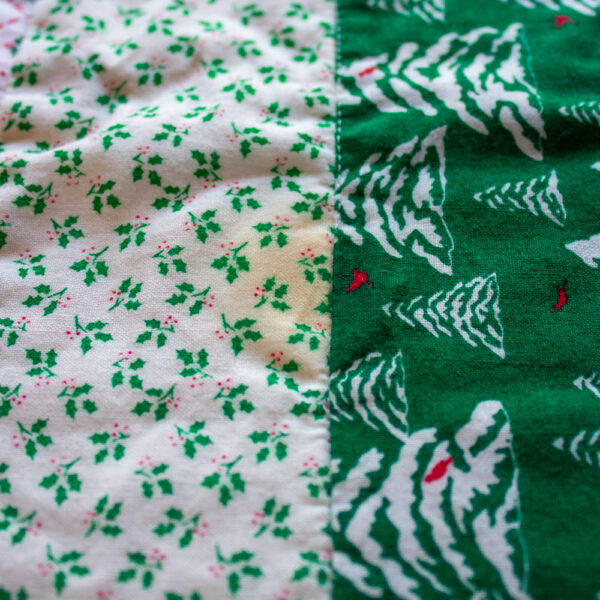
Method 1 (The Gentler Method): Blotting Paper and an Iron
Because we don’t actually live in the Victorian times, alas, substitute white tissue paper, an unbleached paper towel, or even a clean piece of typing paper for the blotting paper.
Fold one of these items a few times until it’s fairly thick, then place it directly under the stained part of the fabric. Put another piece of paper directly on top of the stain, and hold a warm iron to it for a couple of seconds. Lift up the iron and give a little peep at the paper.
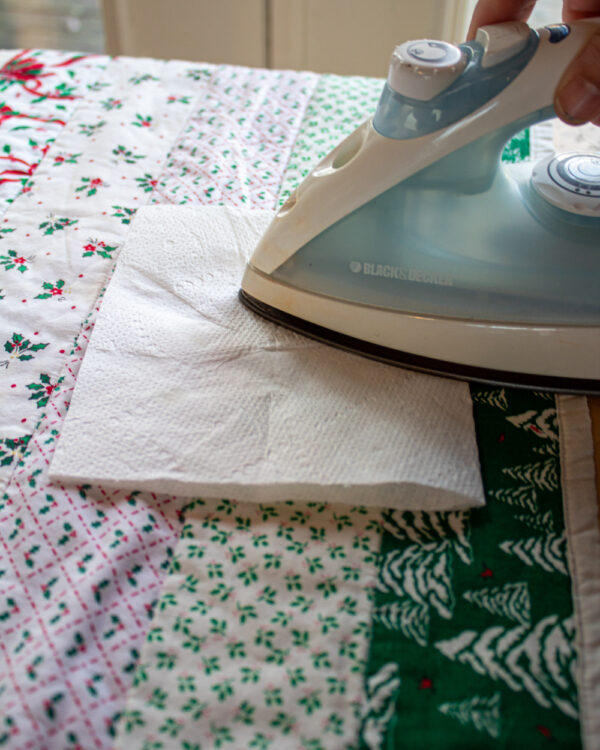
The idea here is that you’ll melt the wax using the least possible amount of heat. As the wax melts, it will be absorbed by the paper, allowing you to eventually lift the entire stain out of your fabric.
You’ll have an easier time with this method if you know the type of fabric and the type of wax you’re working with. Different waxes have different melting temperatures, and so do different fabrics! Cotton, for instance, can easily stand up to an iron temperature hot enough to melt pure beeswax, but I’m not so certain about polyester. If you’re lucky, perhaps you’ve only stained your vintage polyester table runner with soy wax, which has a much lower melting point.
I’m pretty certain that my own vintage table runner is cotton (although, to be fair, I’m less certain about the batting…). My guess that the wax was plain old paraffin, however, is definitely incorrect. The melting point of paraffin is barely higher than that of soy, but even taking a gamble and turning the iron up to high, I lifted practically nothing of this wax. It even still felt hard to the touch!
Method 2 (The More Aggressive Method): Boiling Water
If you’ve ever used my method of removing wax from container candle jars, you know that boiling water is the quickest and easiest way to lift wax from a surface. The problem is that while a glass container can definitely hang out in a pot of boiling water without damage, your fabric might not be so sturdy. Hot water can cause vintage dyes, in particular, to bleed, a situation that might result in a fabric that, while wax-free, looks a LOT worse than it did with the wax on it!
Proceeding with great caution, then, boil a kettle of water. Set up a portable drying rack to suspend the fabric over a surface you’re not afraid to get melted wax or boiling water on (I vote for your driveway or the sidewalk!), then pour a stream of boiling water directly onto the stain.
Your goal here is both to melt the wax with the boiling water and use the momentum of that stream of water to carry the melted wax through your fabric and out the bottom. This is a good method for my vintage table runner, in particular, because I can feel that there’s even more wax clumped in the batting between its two cotton layers.
And this is the method that worked for me! I still don’t know what type of wax was on the table runner, but the boiling water carried it completely away.
But remember when I cautioned you about pigments possibly being heat-set into your fabric using either of these methods? Yeah, the boiling water carried away all the wax, but it left a yellow stain. I’d be happy, regardless, because the stain is much less conspicuous than the wax, but I have a couple more stain-fighting tricks in my arsenal.
Bonus Method for Removing Wax Pigment
If your fabric survived a hot iron or boiling water, it’s probably going to be fine with this method, but proceed cautiously and use your more conservative judgment, regardless.
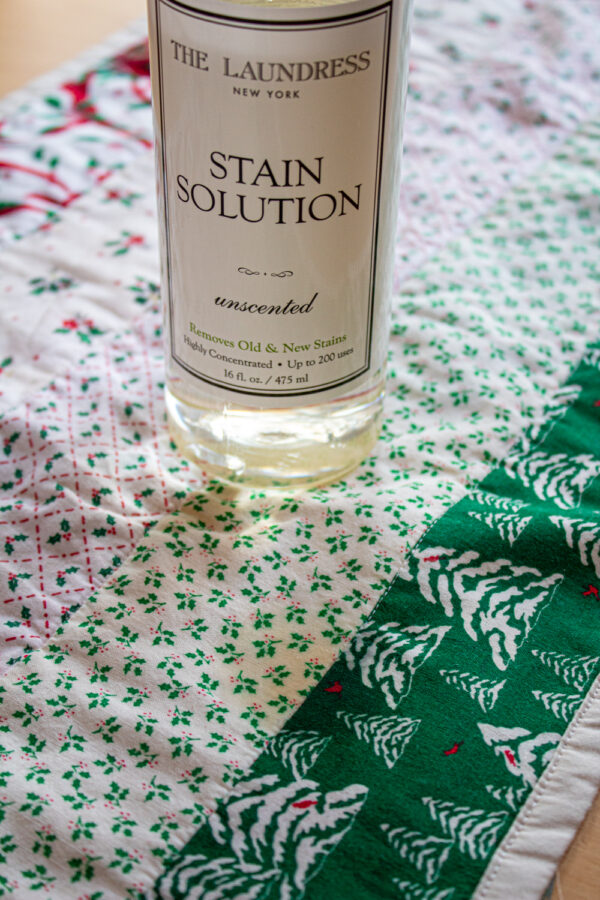
Wet your fabric, then use your finger to rub this Laundress New York Stain Solution into the stain. This stuff is pretty pricey, but I only use it for stain treatment and spot cleaning, so a whole bottle lasts for a LONG time.
Do a quick wash on warm as soon as you’ve rubbed the stain solution in, then pull your wet fabric out of the washing machine and give it a look over. If it’s still stained, rub in a little more stain solution, and then use your finger (you can use a glove if your fingers are tender, but I hand-wash dishes in practically boiling water daily without gloves, so…) to massage in a tiny bit of sodium percarbonate. Sodium percarbonate is an oxygen bleach that’s generally color-safe, but still, this is a more aggressive technique, so be careful.
Again, do a quick warm wash as soon as you’ve applied the stain solution and sodium percarbonate. And again, pull the wet fabric out of the washing machine as soon as the cycle’s complete and give it a look over. If it’s still stained, get your portable drying rack back out and set your fabric somewhere sunny for the afternoon. Be careful if there are other, vivid colors on the fabric that you don’t want to fade, but otherwise, sun bleaching is extremely gentle on all types of fabric. And, as I can attest, since it was approximately 20 degrees out when I sun bleached my table runner, you can sun bleach stains away even when it’s below freezing outside! Your fabric will end up iced over… and stain-free!
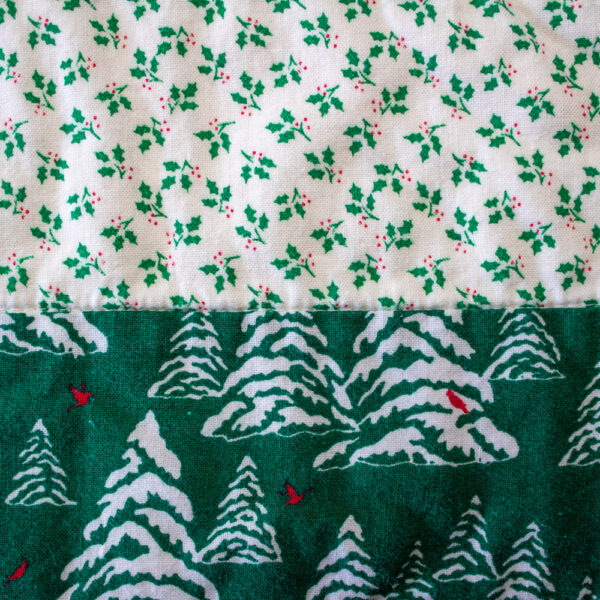
I hope this assortment of methods inspires you to use all of your beautiful linens and quilts and table runners and napkins and doilies and such the way they were meant to be used, instead of hiding them away to save for a day that may never come. When I die, I don’t know if my kids will even want these precious vintage fabrics that I treasure so much, but I do know that they’re more likely to want them and treasure them if I actually use them, sewing them into the memories of their happy childhoods.


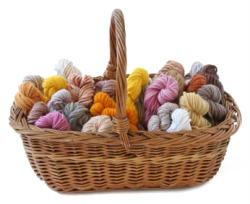




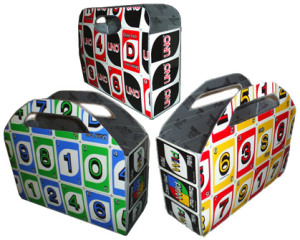
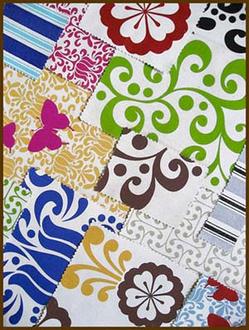
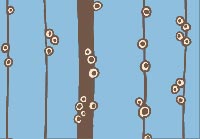
I’ve found hanging leaving stained fabrics outside in frosty weather will remove many stains, even without pre-treatment. Also excellent for brightening whites